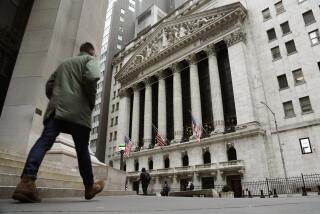Oil Price May Make Dip in Inflation Short-Lived
- Share via
Inflation at the wholesale level fell in April, while consumer sentiment improved and the already robust U.S. economy was projected to outpace even last year’s expansion, according to three separate reports Friday--all of which prompted an upbeat response on Wall Street.
The producer price index, which tracks wholesale prices for finished products, dipped 0.3% in April, reversing two months of 1% increases and notching its biggest drop since February 1999, the Labor Department said.
Falling energy prices led to the decline, resulting from recent moves by OPEC nations to increase crude oil exports. Energy prices fell 4.1%, ending two consecutive months of gains of more than 5%. But the reprieve may be short-lived. Oil supplies have again tightened, pushing the price of crude to a close Friday near $30 a barrel.
The decline in the PPI also masked what economists called signs of creeping inflation in the economy. Wholesale prices for finished goods, excluding energy, rose 0.3%, the government said. Wholesale food prices advanced 1%, with eggs, fish and beef all logging increases.
When food and energy costs were stripped out of the index, the PPI rose by a smaller 0.1% in April, a rate considered modest by economists and steady with the 0.1% rise in March. Prices for computers and light trucks, for example, dipped last month.
“Don’t be fooled, inflation is building in the pipeline,” said Ken Goldstein, economist with the Conference Board in New York. “When you look beyond energy, prices for the materials that go into factories--aluminum, copper, steel and cotton--are going up, about 4% over a year ago.”
The Labor Department’s report won’t dampen the Federal Reserve Board’s ardor for raising interest rates when it meets Tuesday, Goldstein said. Economists expect the Fed to raise short-term rates by a quarter to a half a percentage point to slow the economy and reduce inflationary pressure. The increase would be the sixth since June 1999.
Perhaps relieved by the mildness of the PPI report and comfortable in its expectation of higher interest rates, the stock market rose Friday. The Dow Jones industrial average climbed 63.40 to close at 10,609.37. Nasdaq rose 29.48 to 3,529.06.
In another economic report released Friday, the National Assn. of Business Economists said the economy will grow at a 4.9% rate this year, up from 4.2% in 1999. The survey pointed to strong consumer spending, business investment and a buildup of inventories as factors strengthening the economy.
The group of economists said growth could slow to 3% next year. But it also noted that predictions of a slowing economy have become a recurring theme and have yet to materialize.
Diane Swonk, president of the group and chief economist for Bank One Corp. in Chicago, likened the expanding economy to a car speeding up to 75 mph from 65 mph.
“It’s not that hard to get to 4.9% from where we are,” Swonk said. “Consumer spending is more than robust, auto sales are at record levels. We are pushing the envelope on the speed limit.”
A new concern, Swonk said, is the growing recognition by the financial markets and economists that the surging economy may be developing resistance to the types of interest rate moves the Fed has previously used to cool growth.
“For consumers now, there’s cut-rate auto loans, adjustable-rate loans and teaser-rate loans like you see in the credit card offers. Corporations are going abroad for financings in ways they couldn’t . . . just a decade ago,” Swonk said.
Also Friday, the University of Michigan said consumer attitudes on the economy improved in early May compared with April, according to analysts familiar with the private survey.
“Forget the Fed, forget the PPI, there’s only one number you should keep your eye on: the 3.9% unemployment rate,” said Goldstein of the Conference Board, which also measures consumer sentiment. “That’s all consumers care about.”
Goldstein thinks unemployment could move lower, possibly to 3.7%, adding fuel to the economy and forcing the Fed into continued interest rate increases.
The expansion, which has extended into its record 110th month, continues to build on each round of job growth, he added. More people go to work. More people collect paychecks. More people spend money. More businesses invest to produce goods in demand. The more businesses invest, the more people they hire, and the cycle starts again.
“They might as well be tapping the brakes on a supertanker. Even if they slammed them, it is going to take five miles to stop the ship. This economy is about as good as it gets,” said Goldstein. “It will end someday, however, someday is not this year.”
(BEGIN TEXT OF INFOBOX / INFOGRAPHIC)
Prices Down
Producer price index of finished goods, seasonally adjusted:
*
April: 137.3
*
Bureau of Labor Statistics
More to Read
Inside the business of entertainment
The Wide Shot brings you news, analysis and insights on everything from streaming wars to production — and what it all means for the future.
You may occasionally receive promotional content from the Los Angeles Times.










